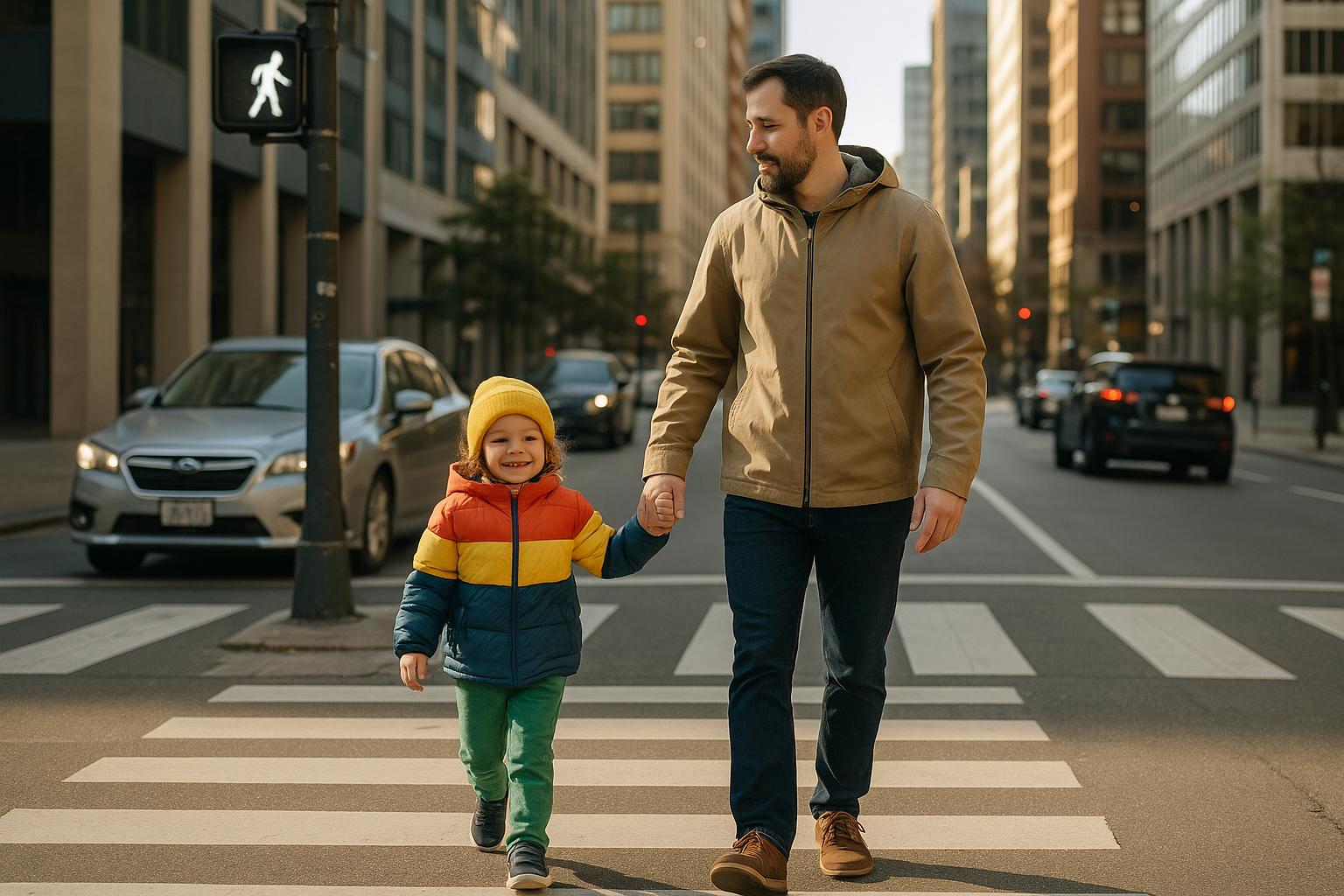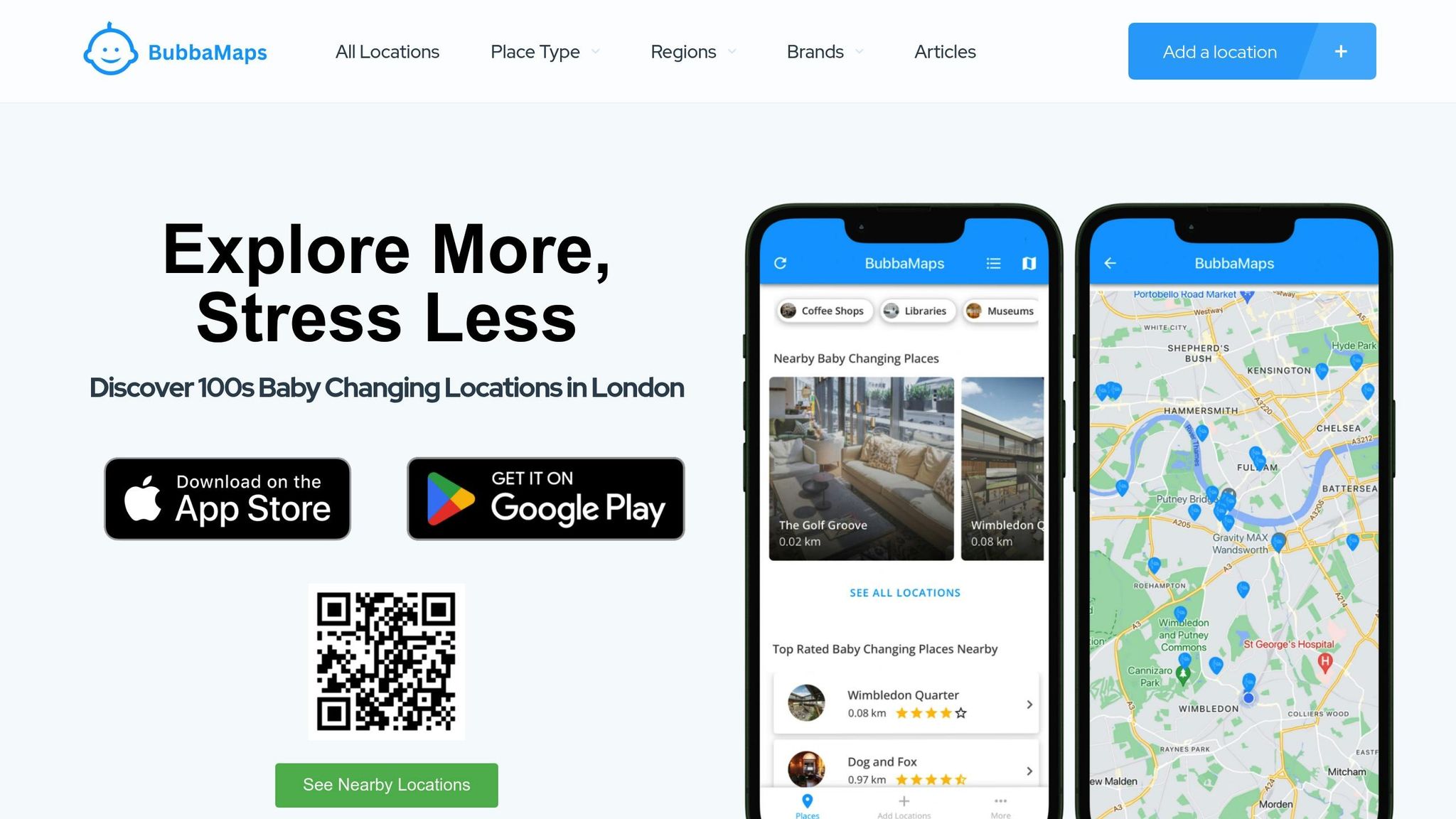
How to Teach Kids Street Safety in Cities
City streets can be challenging for kids to navigate due to busy intersections, traffic signals, and various hazards like construction zones or parked cars. Teaching street safety is a gradual process that evolves as children grow. Here’s a quick breakdown:
- For young kids (under 5): Focus on constant supervision, simple rules like "red means stop", and holding hands near streets.
- For older kids (5-11): Teach them to identify hazards, judge timing and distance, and understand different types of intersections.
- For children with special needs: Use visual aids, step-by-step instructions, and repetition to address individual challenges.
Parents play a key role by modeling safe behavior, practicing together, and gradually giving kids more independence. Tools like BubbaMaps can help plan safer routes and teach navigation skills during city outings. Consistent practice and clear guidance help children build confidence and stay safe in urban environments.
Road Safety Tips for Kids: Stay Safe and Smart!
Teaching Basic Street Safety Skills
When it comes to staying safe on the streets, understanding traffic signals and rules is a critical first step. This knowledge serves as the backbone of street safety, especially for children. Here’s how to approach teaching these skills to different age groups.
Reading Traffic Signals and Rules
For younger children, typically ages 4–6, keep explanations straightforward and easy to grasp. For example, you might say, “Stop signs are red and mean cars must stop,” or “A red light means stop, and green means go.” Introduce the concept of a crosswalk by explaining that it’s a safe place for people to cross the road.
As children grow older, around ages 7–9, you can expand on these basics. Emphasize the importance of always looking in every direction – even when the walk signal is on. Discuss how crossing safely might differ depending on the situation, such as at busy intersections or quieter streets.
How to Teach Street Safety to Kids
Teaching kids street safety goes beyond just explaining rules – it’s about showing them how to stay safe and giving them opportunities to practice. Kids learn best when they see safe behaviors in action and get hands-on experience. By combining demonstrations with gradually giving them more responsibilities, you can help them navigate streets with confidence.
Be a Role Model for Safe Behavior
Children often imitate what they see, so your actions matter. Always use crosswalks or street corners, come to a complete stop at the curb, and look in all directions before crossing. By consistently practicing these habits yourself, you’re setting a strong example for your child to follow. Once they’ve observed you, it’s time to involve them directly.
Practice and Role-Play Together
Practicing together helps kids develop good habits. Create role-playing scenarios, like crossing at a mock intersection or reacting when a vehicle doesn’t yield. These exercises make safety lessons more engaging and memorable. Walking with a buddy – whether it’s a friend, sibling, or family member – adds another layer of safety and accountability. These activities prepare kids for real-world situations and build their confidence.
Gradually Build Independence
Start by letting your child take the lead on familiar routes, like walking to school or heading to a nearby park, while you supervise closely. Over time, you can allow them to take short, independent walks, such as from the car to the school entrance. For kids on bikes, emphasize the importance of using sidewalks in busy areas and staying alert for pedestrians and vehicles backing out of driveways. These steps help them gain independence while staying safe.
sbb-itb-a5e9dda
Teaching Street Safety by Age and Ability
Teaching street safety effectively means considering your child’s age, developmental stage, and unique needs. What resonates with a toddler will differ from what works for an older child, and kids with special needs may require tailored approaches. Adjusting your methods ensures kids can better understand and apply these critical lessons.
Young Children Under 5
For toddlers and preschoolers, safety begins with constant supervision and simple, easy-to-follow routines.
At this age, kids often lack the ability to judge speed or distance and have limited impulse control. That’s why holding hands near streets – even on sidewalks – is a must. Make this a rule that’s non-negotiable.
Repetition is key. Teach them basic rules like “red means stop, green means go” and “stay on the sidewalk.” Reinforce these messages daily to help them stick.
Introduce habits through fun, memorable activities. For example, before crossing any street, teach them to stop at the curb and freeze like a statue. This simple pause can later become a life-saving habit as they grow older.
Use direct, concrete instructions. Instead of vague warnings like “be careful,” say something specific, such as “stay on the gray sidewalk.” Since young children aren’t ready for complex decision-making, your role is to guide and protect them while laying the groundwork for future independence.
Older Children 5-11 Years
As kids grow, they’re ready to take on more responsibility and grasp the reasons behind safety rules. This is the time to introduce more detailed concepts and encourage critical thinking.
Teach them to watch for hazards, such as delivery trucks, cyclists, or construction zones. Explain how parked cars can block their view of oncoming traffic and why they need to be extra cautious in those situations.
Help them practice judging timing and distance. For example, during walks to school or the park, ask questions like, “Do you see any cars coming?” or “Is that car far enough away?” Use these moments to correct their judgment gently and explain your reasoning.
Introduce the idea of different types of intersections. A quiet residential street requires one level of awareness, while a busy multi-lane road with traffic lights demands another. Teach them to recognize pedestrian signals and emphasize that even when the walk signal is on, they still need to check for turning vehicles.
As kids in this age group develop, these lessons help them build the confidence and skills they’ll need to navigate streets more independently.
Children with Special Needs
For children with special needs, safety lessons should be customized to suit their abilities, focusing on building confidence and reinforcing essential skills.
Children with autism, ADHD, intellectual disabilities, or other challenges often benefit from visual aids and step-by-step instruction. For example, picture cards can illustrate how to cross a street, while social stories can walk them through different scenarios. Some children may find scripted phrases like “Stop, look left, look right, look left again, listen, then walk” helpful for remembering the sequence.
Kids with ADHD may need extra help managing impulse control. A simple physical cue, like holding onto a backpack strap, can prevent sudden movements into traffic. Practicing stopping games at home can also strengthen their ability to pause on command.
For children with intellectual disabilities, repetition and hands-on practice are essential. Role-playing with toy cars or action figures can help them grasp safety concepts in a stress-free setting before applying them in real-world situations.
It’s also important to consider a child’s sensory needs. For instance, traffic noise might overwhelm some children, making noise-reducing headphones a helpful tool. Others may struggle to focus amid visual distractions and need extra guidance to stay attentive to safety cues. Collaborate with teachers, therapists, or doctors to develop strategies that align with your child’s specific challenges and strengths.
Using BubbaMaps for Safer City Trips

Navigating city streets with kids can be a challenge, but careful planning makes it much easier – and safer. BubbaMaps offers a handy solution for parents, combining street safety lessons with access to family-friendly facilities during urban outings.
With its community-driven map of over 100 verified baby changing facilities across London, BubbaMaps helps you plan routes that include essential stops. This way, you can focus on teaching street safety while ensuring you’re prepared for any necessary breaks.
Planning Routes with BubbaMaps
Before heading out, take a moment to plan your route using BubbaMaps. The platform highlights safe and verified stopping points in coffee shops, restaurants, museums, and public spaces. This allows you to plan breaks that naturally align with teaching moments.
For instance, start by mapping out your destination and marking a few potential stops along the way. These stops serve dual purposes: they provide a backup if your child needs a diaper change and create opportunities to practice street safety. For example, if you’re walking to a museum, you might plan a stop at a verified coffee shop halfway through. This gives you a chance to practice crossing busy intersections and review key safety tips.
BubbaMaps also includes user reviews that cover accessibility, cleanliness, and family-friendliness. This makes it easier to choose stops where you can comfortably take time to reinforce safety lessons without feeling rushed.
The mobile app’s navigation tools help you find the safest walking routes to each location. Compatible with both iOS and Android, the app lets you adjust your path on the go, whether you prefer quieter side streets or busier areas – depending on your child’s comfort level and readiness. Once your route is set, you can involve your child in the navigation process to further develop their skills.
Teaching Navigation Skills
BubbaMaps isn’t just for parents – it’s also a great teaching tool for older kids. Involve your child in route planning to help them build confidence and learn practical navigation skills. Show them how to identify landmarks and safe crossing points between your starting location and destination.
For kids aged 5-11, take the opportunity to teach them how to read map symbols and recognize different types of locations. For example, explain how entrances to restaurants might differ from museums and how this impacts where you’ll cross streets or navigate pedestrian areas.
You can also use the app to practice estimating walking distances. Ask your child to guess how long it will take to walk from one verified location to another, then compare their guess with the app’s estimate. This activity enhances their spatial awareness and gives them a better understanding of city layouts.
During your walk, use the verified locations as navigation checkpoints. Encourage your child to spot the coffee shop or restaurant from a distance and guide you along the safest route to reach it. This hands-on practice not only builds their confidence but also reinforces the street safety lessons you’ve been teaching.
What’s more, BubbaMaps stays current with updates from its community. By contributing reviews together, you can show your child that creating a safer city is something everyone plays a part in.
Building Confidence Through Regular Practice
Street safety isn’t something children grasp overnight – it takes consistent effort and repeated exposure to safe behaviors. Kids naturally learn by observing, so setting a good example is crucial.
Modeling safe behavior starts with you. If you tell your child to always wait for the walk signal but then dash across the street when you’re in a rush, it sends mixed signals. Instead, stick to the rules you want them to follow, even if it’s inconvenient. Your actions speak louder than words, and consistency helps reinforce the lessons you’re teaching.
Regular city outings are a great way to put these lessons into practice. These trips allow children to repeatedly apply essential safety skills in real-world settings. Over time, this guided practice builds their confidence and complements earlier strategies like role-playing.
Planning your route can also make these outings more effective and less stressful. Tools like BubbaMaps can help you map out routes that include verified baby-changing facilities, making your trips more purposeful. While your child learns navigation and safety, you benefit from a more structured, convenient outing. Safety lessons feel natural when integrated into everyday routines rather than forced.
Gradually introducing independence is another step in building their confidence. Start with familiar routes and slowly work up to more complex scenarios. This gradual approach ensures they feel secure while learning to navigate safely. As you increase their independence, align these lessons with the age-specific guidelines discussed earlier to match their developmental stage.
Keep in mind that every child learns at their own pace. Some may adapt quickly, while others need more time and practice. The key is to maintain consistent expectations and provide plenty of opportunities for hands-on learning. With regular practice, your child will develop the confidence they need to navigate urban environments safely.
FAQs
How can I teach street safety to my child with special needs?
Teaching street safety to children with special needs calls for a patient, consistent approach with strategies tailored to their unique learning styles. Start by incorporating visual aids – traffic light symbols, stop signs, and simple illustrations – to communicate basic concepts in a clear and straightforward way. These tools can make abstract ideas more concrete and easier to grasp.
Engage them with role-playing activities, like pretending to cross the street at home. This turns learning into an interactive experience, making it both enjoyable and memorable. Demonstrating safe behaviors yourself is equally important. Show them how to look both ways, wait for the walk signal, and cross at designated areas. Kids often learn by watching, so modeling these actions helps reinforce the lessons.
Repetition is key. Establish predictable routines to help them internalize these skills over time. During practice, always provide close supervision to ensure their safety and offer plenty of positive feedback for correct actions. With consistent effort and encouragement, your child can build the confidence and awareness needed to navigate streets safely.
How can I help my child become more confident and independent when navigating city streets?
Start with short, supervised walks in quiet, low-traffic areas to introduce your child to the basics of street safety. Teach them essential habits like looking both ways before crossing and recognizing traffic signals. Once they’re familiar with these basics, gradually expose them to busier streets, guiding them as they practice crossing at marked crosswalks or corners.
As their confidence grows, let them try navigating simple routes independently. Remind them to stick to sidewalks, avoid distractions like phones, and make eye contact with drivers before crossing. Regular practice paired with positive encouragement will help them build the skills they need to travel safely on their own.
How can BubbaMaps help parents teach kids street safety during city outings?
BubbaMaps isn’t just about finding clean and convenient baby changing facilities – it’s also a tool that can make city outings with kids safer and less stressful. By eliminating the hassle of hunting for family-friendly amenities, parents can spend more time focusing on teaching kids essential street safety skills. Whether it’s learning how to cross roads properly, understanding traffic signals, or staying alert to their surroundings, these lessons become easier to teach when parents aren’t preoccupied.
Another advantage of using BubbaMaps is the ability to plan your route ahead of time. Knowing where to pause for breaks can make exploring the city with children feel more manageable and enjoyable. A well-thought-out plan allows kids to practice safety skills in real-life situations without feeling rushed or overwhelmed, turning every outing into a learning experience.














